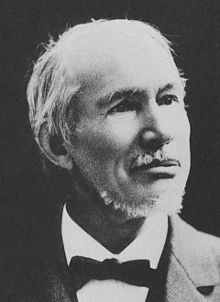George William Hill

George William Hill (March 3, 1838 – April 16, 1914), was an American astronomer and mathematician.
Life
Hill was born in New York City, New York to painter and engraver John William Hill and his wife, Catherine Smith.
He moved to West Nyack with his family when he was eight years old. After attending high school, Hill graduated from Rutgers University in 1859. In 1861 he was hired by John Daniel Runkle[1] at the Nautical Almanac Office in Cambridge, Massachusetts. His work focused on the mathematics describing the three-body problem, later the four-body problem, to calculate the orbits of the Moon around the Earth, as well as that of planets around the Sun.
The Hill sphere, which approximates the gravitational sphere of influence of one astronomical body in the face of perturbations from another heavier body around which it orbits, was described by Hill.
He became president of the American Mathematical Society in 1894, serving for two years. He was elected to the Royal Society of Edinburgh in 1908, as well as to the academies of Belgium (1909), Christiania (1910), Sweden (1913), the Netherlands (1914)[2] among others.
Hill died in West Nyack, New York. He never married and had no children.
Legacy and honors
- Gold Medal of the Royal Astronomical Society (1887)
- Damoiseau Prize from the Institut de France (1898)
- Copley Medal (1909)
- Bruce Medal (1909)
- Hill (crater) on the Moon
- Asteroid 1642 Hill
- Hill Center for the Mathematical Sciences at Rutgers University's Busch Campus
See also
References
- ^ Hockey, Thomas (2009). The Biographical Encyclopedia of Astronomers. Springer Science+Business Media. ISBN 978-0-387-31022-0. Retrieved August 22, 2012.
- ^ "G.W. Hill (1838 - 1914)". Royal Netherlands Academy of Arts and Sciences. Retrieved 21 July 2015.
Bibliography
- The collected mathematical works of George William Hill vol. 1 (Carnegie Institution of Washington, 1905–1907)
- The collected mathematical works of George William Hill vol. 2 (Carnegie Institution of Washington, 1905–1907)
- The collected mathematical works of George William Hill vol. 3 (Carnegie Institution of Washington, 1905–1907)
- The collected mathematical works of George William Hill vol. 4 (Carnegie Institution of Washington, 1905–1907)
External links
- 1838 births
- 1914 deaths
- American astronomers
- 19th-century American mathematicians
- 20th-century American mathematicians
- Recipients of the Bruce Medal
- Recipients of the Copley Medal
- Members of the Royal Netherlands Academy of Arts and Sciences
- Members of the Royal Swedish Academy of Sciences
- Recipients of the Gold Medal of the Royal Astronomical Society
- Foreign Members of the Royal Society
- Presidents of the American Mathematical Society
- Rutgers University alumni
